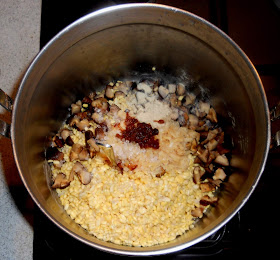The Chinese are renowned for some exotic soups, notably shark’s fin and bird’s nest. These are only likely to be served in large restaurants—I’ve only ever had either when attending a wedding banquet—but both share one characteristic. They may have lots of expensive ingredients, but they are what my friend Barry calls ‘watery soup’. In other words, the liquid part of the soup is just a broth.
This description also fits the kind of soup that you’re likely to be served in a street cafe or dai pai dong. I make it myself (it’s easy enough). I have a soup pan that comfortably holds eight portions, for which I buy one catty (20 ounces) of sai see kwat, a cut of pork from around the base of the spine that comes apart when cooked. All other cuts of pork go hard when subjected to the same treatment. The other major ingredient is a carrot. What? Just one? You can forget the tasteless baby carrots you can buy in the UK. The carrot I buy has a wide end that is 8–9cm in diameter. And the flavour is unbelievable. Paula reckons that it develops incrementally over the four days that it takes to finish a pan.
However, I make another soup that I rather facetiously call ‘Chinese soup’. I should explain the reason for the name: all the ingredients, apart from the water, pepper and salt, are Chinese ingredients, yet I would be astonished if anything remotely similar is being offered in any Cantonese restaurant anywhere in the world. This must sound like an empty assertion, so I should explain the reason for my confidence.
The principal ingredient in my Chinese soup is dried split green beans, the same beans that are used to produce bean sprouts. However, the only way I’ve seen this ingredient being used is as a dessert. It is boiled in water, sugar is added, and it is reduced to a paste, a dollop of which is inserted into a small ball of rice-flour dough. This is then steamed. The Cantonese also do something similar with red beans: boil them up in a soup (hung tau sa) and add sugar.
Contrast this with English cuisine, where peas and beans are invariably served as part of a savoury course. My mother used to add lentils to her pans of soup, which also included ham, carrots and onions. It also automatically thickened the liquid, and boiling up split green beans has the same effect. This is why I introduced this account by pointing out that Chinese soups tend to be ‘watery’. My Chinese soup isn’t.
It is particularly efficacious in cold weather, and the thickness of the liquid means that a single bowl is very filling. So what are my other ingredients? There are two main ones: dried scallops (conpoy) and dried Chinese mushrooms. Dried scallops are so expensive that you can expect to pay around £60 for a pound of large, unbroken ones—these are also a regular feature of wedding banquets—but for soup, broken pieces are fine, and far, far cheaper. I’ve been using baby scallops recently, which are also reasonably cheap.
I should point out here that dried foods such as these have much more intense flavours when rehydrated than the fresh equivalents—my son Siegfried once chided me for using fresh Chinese mushrooms in a dish that I’d made several times previously with dried mushrooms. The fresh ones had hardly any taste.
When I’m in Hong Kong, I always have a pan of soup on the go, either my Chinese soup or the broth that I described earlier, but when I’m in Penrith, I make only the occasional pan of the former. However, I’ve just been preparing a new pan, and I thought that you might like to learn how it’s made.
The split green beans should be soaked overnight in cold water:
The photo also includes an unopened packet.
The conpoy and mushrooms should be steeped in boiling water and left for a couple of hours:
…after which the individual strands of conpoy can be teased apart by rubbing, and the mushrooms chopped into small pieces:
Once the split green beans have been soaked, the water becomes cloudy because of all the fine powder. It is therefore necessary to wash the beans several times. If you don’t, the soup will froth up uncontrollably when heated. The water used to soak the conpoy and the mushrooms goes in the soup:
The reddish brown blob in the middle of the pan is a generous teaspoonful of XO sauce; the other ingredients are a moderately heaped teaspoon of sea salt and half a level teaspoon of white pepper. The photo shows my soup pan just before I add boiling water, after which I bring it to the boil:
This photo shows the soup just before I put the lid on and place the pan in its thermal container. All I need to do is leave it for a few hours, during which the split green beans completely disintegrate. And this is the result:
I don’t know whether it’s possible to buy the split green beans in the UK—there are two major supermarket chains in Hong Kong, ParknShop and Wellcome, but only the latter stocks this product, from which I conjecture that there isn’t that much demand. I bring half a dozen packs over from Hong Kong every year, although you can get a similar result using channa dal, which is split yellow peas. However, the pieces are larger, so it is necessary to boil the soup for 15–20 minutes before placing the pan in the thermal jacket.
As I suggested earlier, this soup is unlikely to be on the menu of a typical Chinese restaurant, but if by some unlikely coincidence a Chinese chef happens to be reading this, please try it. You have my permission to call it ‘gweilo soup’.






Sounds delicious!
ReplyDeleteIt is Sandy, believe me.
Delete